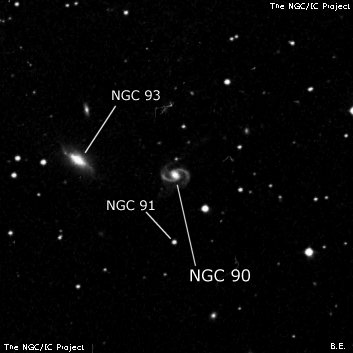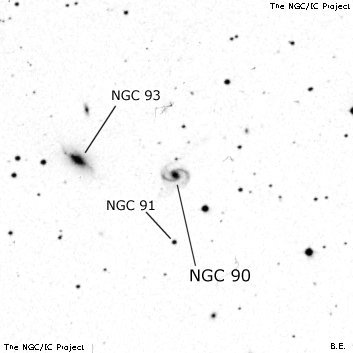NGC/IC Project Restoration Effort
(This is a very very beta version)
NGC90


Basic Information
Location and Magnitude
Right Ascension: 0:21:51.6
Declination: +22:24:2
Constellation: AND
Visual Magnitude: 13.7
Historic Information
Discoverer: Mitchell
Year of discovery: 1854
Discovery aperture: 72.0
Observational
Summary description: vF, lE
Sub-type: SBc
Corwin's Notes
=====
NGC 90, 91, and NGC 93. Dreyer has confused the observations of these
objects. Lord Rosse's observations make it clear that he and his assistants
saw only two nebulous objects here, so one of the "Ld R"'s has to be
striken from the "Other Observers" column of the NGC. The offsets make it
clear that the Irish observers saw what we now call NGC 90 and NGC 93.
What do the observations of Schultz and d'Arrest have to say? Schultz's
positions for all three objects -- not just one as the NGC credits --
precessed from the published equinox of 1865.0, agree to within two or three
arcsec in all three cases with modern data from GSC. These pin down the
three objects and show that NGC 91 is a star (Bigourdan also called the same
star NGC 91 in his Observations). D'Arrest's positions are not quite as good,
but fall within 20 arcsec of the galaxies. His descriptions of the locations
and magnitudes of the nearby stars are also good, and confirm the
identifications.
So, NGC 90 should be credited to Lord Rosse, Schultz, and d'Arrest (rather
than just Lord Rosse and Schultz), NGC 91 to Schultz alone (Lord Rosse and
d'Arrest never commented on this star), and NGC 93 again to all three
observers. To the description for NGC 90 should be added "* 13 sp."
There are several other identification problems in the NGC 80/83 Group, too.
See NGC 81, 82, and 84, as well as IC 1547.
Steve's Notes
=====
NGC 90
48" (10/30/16): at 488x and 610x; bright, oval 3:2 E-W, sharply concentrated with a very bright roundish core (slightly elongated at 610x) and a fairly large oval halo, ~60"x40". A spiral arm is visible on the northwest side, curling clockwise to the south but the long, thin tidally stretched extensions to the northwest and southeast were not seen. Forms a striking (interacting) pair with NGC 93 2.8' ENE. A mag 12 star is 1.3' SW. Although this galaxy is often identified as NGC 91, that number applies to a mag 14.8 star 1.9' S.
NGC 90 = Arp 65 was classified as a Spiral galaxy with small, high surface-brightness companions on arms. LEDA 1669552, the "companion" just beyond the northwest tidal extension (2.4' NW of NGC 90), appeared faint (V ~17.1), small, elongated 3:2 N-S, 10"x6". A mag 15.7 star is 30" SE. No redshift is available on this object, so it may lie far in the background.
18" (11/22/08): faint, fairly small, elongated 3:2 ~E-W, 0.5'x0.35'; contains a small, round, brighter core. NGC 93 lies 2.8' ENE and a mag 12 star is 1.4' SW.
17.5" (9/19/87): very faint, small (only the central portion of the galaxy observed), slightly elongated, weak concentration. A mag 12 star is 1.3' SW. Forms a pair with NGC 93 2.8' E. Located on the east side of the NGC 80 group 7.0' ESE of NGC 83.
13" (9/29/84): very faint, elongated NW-SE. A mag 13 star is 1' SW.



